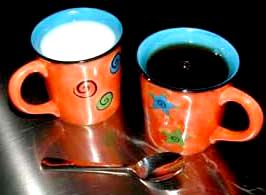Mixing it up

I start with two full mugs, one containing milk and the other containing tea, in exactly equal amounts. I transfer 3 spoonsful of milk from the first mug to the second, and stir thoroughly. Then I transfer 3 spoonsful from the now-milky tea in the second mug back into the first mug.
Which is greater: the amount of tea now in the first mug or the amount of milk now in the second mug?
The solution
This has to have been the most popular Plus puzzle ever! Lots of readers sent in solutions, some using logic, some algebra, many right, some wrong.
The right answer is perhaps a little unintuitive - the amount of tea now in the first mug is exactly equal to the amount of milk now in the second mug!.
To see this, you could use a bit of algebra, expressing the amount of milk and tea in each cup in teaspoonsful and then adding and subtracting 3's. You'll get the right answer, but it's easier if you think about it this way:
Write V for the initial total volume in each mug. At the end, each mug still has a total volume V. Write W for the volume of milk in the second mug at the end (this means there is V-W of tea). By conservation of milk, since there was V to start with, there must be V-W of milk in the first mug and hence W of tea. So there is exactly the same amount of tea in the first mug as milk in the second.
Back to main puzzle page
Anonymous
What bout the dilution of the tea with milk?
Anonymous
if you took 30ml out of a 60 ml milk thing and added it to the tea you would have 2/3 tea 1/3 milk so when you take 30ml from the tea you would take 20ml tea and 10ml milk meaning you would have 20ml milk remaining and 20ml tea and 10ml of the original milk in to the milk so basically you only add 20ml to each.
Anonymous
is this talking about the volume of each mug or just tea ?
Anonymous
If you imagine each mug to be filled with 100 balls representing droplets, then it is easier. If you take, let's say 25 droplets of tea into the milk, you have in one mug, 75 drops of tea and in the other 100 drops of milk and 25 drops of tea. Then, take 25 drops back, (staying equal to 25 drops, of course) let's say 5 drops of tea and 20 drops of milk. You then have 80 drops of tea and 20 drops of milk in one mug, and 80 drops of milk and 20 drops of tea in the other.